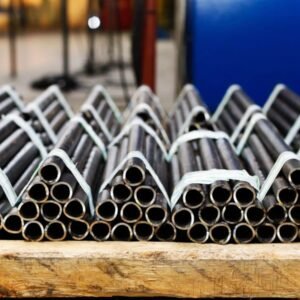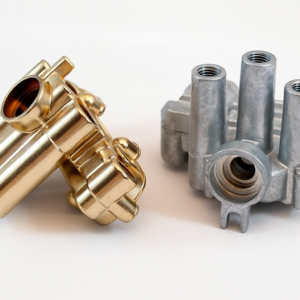の正確な世界で CNC加工, 資料は独自の独自の機会と課題を提示します. これを完全に例として例示する1つの素材 テフロン, より正式に知られています ポリテトラフルオロエチレン (PTFE). この記事では、Teflon/PTFEの機械加工の徹底的な調査を提供します, 考慮事項をカバーします, 専門家のヒント, ベストプラクティス, プロジェクトが最適な結果を達成できるようにするためのアプリケーション.
Teflon/PTFE材料とは何ですか?
ポリテトラフルオロエチレン (PTFE), 一般的に、その貿易名Teflonによって認識されます, 特性の並外れた組み合わせで知られているテトラフルオロエチレンの高性能合成フルオロポリマーです:
高耐熱性: 継続的な動作温度で安定性を保持します 260℃ (500°F).
非常に低い摩擦: 固体材料の間で摩擦の最低係数の1つを持っています, 潤滑および焦げ付き防止アプリケーションに最適です.
優れた化学的不活性: 攻撃的な化学物質の膨大な配列に抵抗します, 酸を含む, アルカリ, 溶媒, と燃料.
優れた電気断熱: 例外的な誘電体は、電子機器で非常に貴重です.
低重量と耐久性: 軽量でありながら非常に耐久性があります, 航空宇宙に最適です, 自動車, および産業用途.
Teflon/PTFEをCNC加工でユニークなものにしている理由?
マシンテフロンは、その特徴的な物理的特性のために特別な考慮事項を提示します:
焦げ付き防止の特性: 最終使用には有益です, この特性は、PTFEが切削工具の下で塗る傾向があるため、加工を複雑にします.
熱伝導率が低い: 機械加工中に発生した熱は局所化されたままです, 危険な変形と融解.
柔らかさと柔軟性: 穏やかな切断技術と特殊なツールを要求します.
クリープ速度が高い: テフロンは徐々に持続的な圧力の下で変形します, 設計と機械加工中に慎重な寸法手当が必要です.
化学的不活性性: 機械加工中に維持することが重要です, 特にシーリングおよび精密成分で.
Teflon/PTFEのさまざまな機械加工プロセス
いくつかの機械加工方法は、正確で正確なテフロンコンポーネントを実現できます:
CNCフライス加工
CNCミリングは、正確で複雑な部分の形状を提供します. PTFEを効果的に機械加工する:
シャープなシングルポイント切削工具を利用します (できれば炭化物またはHSS).
慎重にバランスの取れた切断速度を使用します (200-400 メートル/分) およびフィードレート (0.1-0.25 mm/回転) 過度の熱と変形を防ぐため.
CNC旋削加工
CNCターニングは、円筒形および回転的に対称的なPTFEパーツに適しています:
Sharpを選択します, ポジティブなレーキ角切削工具.
中程度から遅い速度とより速い飼料速度で動作し、熱の蓄積と材料の変形を最小限に抑える.
掘削とタッピング
PTFEの正確な穴と糸を機械加工することは、その柔らかさのために挑戦的です:
放物線フルートジオメトリと高いヘリックス角を備えたドリルを使用してください.
ドリル速度を慎重に制御します (50-100 メートル/分) チップの除去を支援するためにペックドリル.
柔らかい素材のために明示的に設計された精度のタップを使用して、特大または破れた糸を防ぐ.
研削と仕上げ
精密粉砕は、正確な寸法と表面仕上げを実現します:
中程度の速度でダイヤモンド研削輪を使用します.
頻繁な冷却間隔を組み込み、発生した熱を管理します.
ダイカッピングとウォータージェット切断
シートとプレートの代替方法:
薄いシート用のダイカットは、正確な形の迅速な生産を保証する.
ウォータージェット切断は、熱の歪みなしに厚いPTFEシートを効果的に削減する, 必要に応じて研磨添加剤を使用します.
Teflon/PTFEを加工するための本質的な考慮事項と専門家のヒント
広範なCNC加工体験に基づいています, Teflon/PTFEを効果的に連携するための重要なプラクティスを以下に示します:
ツールの選択:
炭化物または高速鋼で作られた鋭いツールは、最先端を維持し、熱発生を最小限に抑えるために不可欠です.
熱生成を制御します:
クーラントを利用します, 中程度の速度, 過熱と変形を防ぐためにシャープネスを維持します.
適切な材料サポート:
カスタムフィクスチャーは、機械加工ストレスをしっかりと保持し、均等に配布します, 反り防止.
素材の塗抹標本を最小化します:
より遅い速度を採用します, 鋭いツール, 正しい飼料レート, そして、おそらく剛性を高めるために一時的にPTFEを凍結します.
クリープの設計調整:
素材のクリープ動作を因数分解します, 長期的なパフォーマンスを確保するために、それに応じて寸法公差を調整します.
表面仕上げ技術:
微妙なサンディングを使用します, 研磨, または滑らかにするための化学エッチング, バーなしの仕上げ.
環境安全対策:
適切な換気とダスト抽出システムを維持して、細かいPTFE粒子を効果的に管理する.
精度と耐性の管理:
保守的な寛容の範囲 (通常、±0.05 mmまたはタイト) アドバイスされています, 変形とクリープの手当があります.
討論とエッジ仕上げ:
穏やかなマニュアルまたは化学的否定的な方法を適用して、一部の完全性を維持し、変形を避けます.
熱と圧力の変形の防止:
内部ストレスを緩和するために、粗い段階と仕上げ段階の間に部品が休むことを許可します, 機械加工シーケンスを慎重に計画します.
最終検査と品質保証:
マシン後の徹底的な寸法検査により、仕様への厳密な順守が保証されます.
CNC加工がTeflon/PTFEに最適な理由
CNC加工は、特にPTFEに適しています:
精度と複雑さ: CNCは高い精度を提供します (±0.01 mm典型) および手動の方法で比類のない複雑な部分機能.
一貫性と再現性: 一貫した大量生産に最適です, 実行中に同一の標準を維持します.
材料廃棄物の削減: PTFE使用量を最大化します, 精密材料除去による部品あたりのコストを最小化します.
運用上の柔軟性: 製粉できる, 旋回, 掘削, PTFEのニーズに合わせた複雑な3D操作.
制御された機械加工環境: CNC加工条件は安定していて一貫しています, 敏感なPTFE加工に最適です.
機械加工されたテフロン/PTFEパーツのアプリケーション
機械加工されたPTFEは非常に用途が広く、さまざまなセクターに広く適用されます:
航空宇宙: ベアリング, アザラシ, 耐熱性と低摩擦が必要なガスケット.
医療産業: 手術ツール, インプラント, 化学的に不活性な医療機器コンポーネント.
エレクトロニクス: 高性能電気絶縁体, コネクタ.
化学処理: 腐食耐性ポンプ, バルブ, 配管.
自動車: under-hoodシール, 絶縁体, 高温耐性成分.
食品産業: フードセーフ, 焦げ付き防止処理装置.
半導体製造: ウェーハキャリア, 化学耐性絶縁成分.
Teflon/PTFEの機械加工の短所
有益ですが, PTFE加工には固有の欠点があります:
260°C未満の運用温度に限定されています.
クリープ誘導変形, 長期的な負荷を負担するアプリケーションに挑戦します.
代替と比較して機械的強度が低い (ピーク, ナイロン).
結合の難しさには、特殊な接着剤と表面処理が必要です.
専門的なテクニックにより、機械加工コストが高くなります.
PTFE生産化学物質に関する環境上の懸念.
複雑さの機械加工には、専門家レベルの処理が必要です.
Teflon/PTFEの代替資料
Teflon/PTFEが不適切である場合, 次の代替エンジニアリングプラスチックが実行可能です:
ピーク: 優れた機械的強度, 熱安定性, そして耐摩耗性.
ナイロン: 合理的な機械的強度と耐摩耗性を備えた費用対効果の高い代替品.
ポリプロピレン: 中程度の温度での良好な耐薬品性.
PVDF: PPよりも優れた化学耐性とより良い寸法安定性を備えたフルオロポリマー.
UHMW: 摩耗集約型アプリケーションの優れた衝撃強度と耐摩耗性.
PCTFE: 寸法安定性が向上し、PTFEよりも低いクリープ速度を持つ化学耐性.
結論
Teflon/PTFEの機械加工には、そのユニークな特性の深い理解が必要です, 戦略的計画, 正確なツール, 洗練された機械加工アプローチ. 提供された考慮事項とヒントを順守することによって, 製造業者は、多様な産業用アプリケーション全体でPTFEの大きな可能性を解き放つことができます.
で 精度の高いトップ, 当社のCNC加工の専門知識と専用サポートは、高品質の利益を保証します, 正確な要件に合わせて調整されたPrecision-Machined Teflonコンポーネント.




